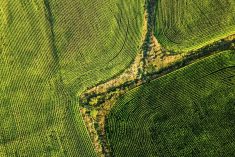Glacier FarmMedia—Farm Credit Canada has invested $5 million into the accelerated breeding program at the Global Institute for Food Security.
Chief executive officer Justine Hendricks announced the funding at Canada’s Farm Show June 18, saying she was thrilled to announce the partnership.
“The accelerated breeding program brings together cutting edge science and practical agricultural knowledge. It will bring new crop varieties and livestock genetics to producers and other stakeholders much faster, which will stimulate rural economic growth and increased revenue,” she said.
Hendricks said sustainability is a key part of FCC’s new strategy, and GIFS’ research into just how sustainable Saskatchewan and Canadian crops are compared to the rest of the world highlights farmers’ good work.
Read Also

Federal budget shows remaining disconnect between agriculture, policymakers, panelists say
Canada’s agriculture sector is still disconnected from policymakers in some ways, say panelists at a CAPI webinar
“They found that a bushel of wheat grown in Saskatchewan would need to be on a boat and circle the world 3.5 times to reach the same carbon footprint as some of its global competitors, and that’s something to be really proud of,” she said.
GIFS CEO Steven Webb said the funding will help Canada “get back on the productivity gain timeline.”
The FCC program will deliver innovative products faster with better yields, disease resistance and quality traits, he said.
Genomic selection, bioinformatics, speed breeding and computational simulations are already proven to increase the rate of genetic gain for crops and livestock. Webb said the dairy industry has used these technologies for more than 20 years, while corn and soybean breeders have used them for more than a decade.
He said this means breeders at GIFS will get the same access, and that will boost productivity and reduce the time to access new varieties.














